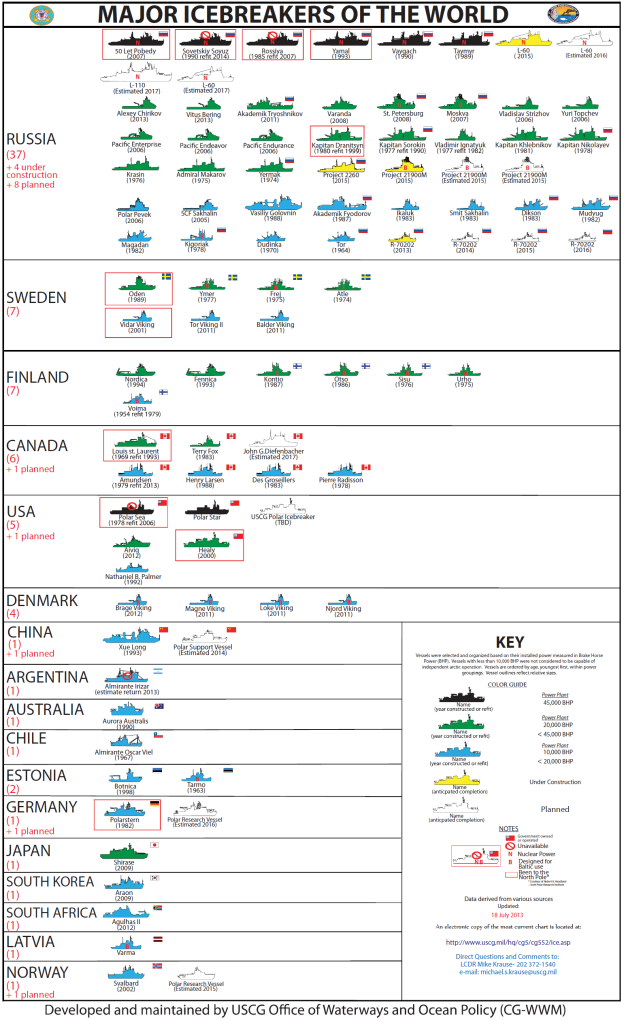The following is the July 18, 2013 review by the U.S. Coast Guard of Major Icebreakers of the World.
The Coast Guard Office of Waterways and Ocean Policy (CG-WWM) began producing the chart of major icebreakers of the world in July 2010. Since then, we have gathered icebreaker information and recommendations from a variety of sources and experts, including icebreaker subject-matter experts, internet posts, news updates, Arctic experts and Coast Guard offices with icebreaker equities. We validate our information within the public forum and update the chart at least semi-annually based on new information and feedback. This chart represents the Coast Guard’s current factual understanding of the major icebreaker fleet. This chart is not intended for icebreaker fleet comparisons and no inference should be drawn regarding a country’s icebreaker “ranking” against another.
Scope. Vessels meeting the general definition of a polar icebreaker per the 2007 National Research Council report on Polar Icebreakers in a Changing World are included. These vessels “have sailed in significant sea ice in either the Arctic or the Antarctic,” have “ice strengthening sufficient for polar ice” and possess “installed power of at least 10,000 horsepower.” Minimally ice-strengthened ships (enough to survive in ice, rather than operate in it) and icebreakers of less than 10,000 horsepower are not included. With the exception of the Baltic icebreakers, this chart does not indicate where their owners may actually operate them. In addition, the chart does not specify whether a vessel’s crew is civilian or military.
Classification Methodology: The chart organizes the icebreakers first by country, then by installed power category, and finally in order of placement in service, youngest to oldest. The chart colors icebreakers by their relative capability estimated using brake horsepower as the most common basis. The most capable icebreakers are black, the next level sea-green and the lightest icebreakers are blue. Icebreakers in construction are colored yellow, and planned icebreakers are white. Planned icebreakers are placed on the chart if we can reliably state they are funded. The chart identifies government-owned or -operated icebreakers with the country’s flag next to the icebreaker. Nuclear-powered icebreakers are marked with an N. Baltic icebreakers designed to operate solely in seasonal, first-year Baltic Sea ice but meeting the ice-strengthening and horsepower criteria are marked on the chart with a B. Most Baltic icebreakers may not have operated in the Arctic due to concerns with open-ocean sea-keeping ability for open water transits.
Fleet numbers and Icebreaker Size in Context. The fleet numbers and icebreaker size tend to align along each county’s economic necessity for icebreaker resources. For example, the economies of Finland, Russia and Sweden have greater dependence on major icebreakers to pursue economic goals in the Arctic and Baltic winters than the economies of other nations. Also, ice in these countries’ shipping lanes, rivers and ports forms earlier, lasts longer, and requires more power to break, requiring more extensive icebreaking capabilities. Similarly, the Canadian icebreaker fleet supports summer access and supply to Canada’s Arctic communities. In contrast, in addition to the polar icebreakers already listed, the U.S has a number of icebreakers operating in the Great Lakes, New England and the mid-Atlantic to facilitate commerce and for exigent circumstances, but these are not listed in this chart because the icebreakers are not required to meet the threshold of at least 10,000 BHP.






